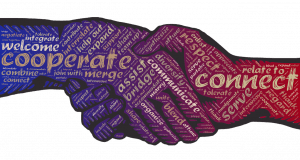
johnhain / Pixabay
We recently hosted the Year 9 Mathematics cohort for a few lessons over this past term. Traditionally, the Information Centre rarely hosts Mathematics classes, but a recently graduate Mathematics teacher wanted a more collaborative approach to learning. He devised a series of lessons that were aimed at developing the student’s skills in geometry through collaborative learning groups but needed additional bodies and space to ensure it ran effectively. By using the library and its flexible learning spaces to run these collaborative learning sessions, the students were able to gain assistance from their peers, their own teachers and the teacher librarians. This mean that there was more specific support available for facilitating the learning, which led to an overall improvement in student outcomes. From a teacher librarian perspective, these sessions were a wonderful way to develop student learning through collaboration and cooperation, and a fantastic outcome for all.
Classes come to the Information Centre from across the school to access the library for resources, the flexible learning spaces, as well as gain assistance from the teacher librarians. This assistance may be in the form of information seeking, but the fact is that the primary focus of any teacher librarian is to facilitate the teaching and learning of their school community (ALIA & ASLA, 2004). Research from over thirty different studies across the world has indicated that the presence of qualified teacher librarians has a strong positive correlation to improved learning outcomes (Hughes, 2013). This access can occur in a variety of ways but most often occurs in the form of team teaching with the classroom teacher, explicit instruction, targeted assistance with inquiry learning, as well as informal and formal research support, essay writing workshops, the implementation of literacy and numeracy strategies, and various other teaching and learning programs. This breath of access means that the teacher librarians themselves can be considered a resource to improve student learning because they enable students and teachers to use the library and all its resources to its fullest potential (ALIA & ASLA, 2016).
School libraries are more than just book repositories, but rather they are dynamic spaces where information can be accessed, and knowledge constructed for a range of purposes. The reality is that time spent into the library in the pursuit of knowledge often leads to improved efficiency and efficacy because of the qualified teacher librarians that support student learning.
References.
ALIA & ASLA. (2004). Standards of professional excellence for teacher librarians. Australian School Library Association. https://read.alia.org.au/alia-asla-standards-professional-excellence-teacher-librarians
ALIA, & ASLA. (2016). Statement on Teacher Librarians in Australia. Australian School Library Association. https://asla.org.au/resources/Documents/Website%20Documents/Policies/policy_tls_in_australia.pdf
Hughes, H. (2013). School libraries and teacher librarians: evidence of their contribution ot student literacy and learning. Curriculum & Leadership Journal 11(12). http://www.curriculum.edu.au/leader/school_libraries_and_tls,36453.html?issueID=12777
